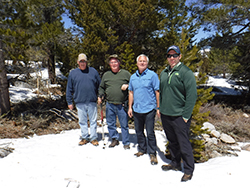
Porcupine1: NRVP participants Greg Moore, Mike Maulhardt, Charles Brown and Ben Smith volunteered to service and maintain porcupine stations at Red Lake Wildlife Area.
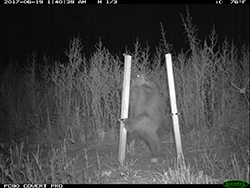
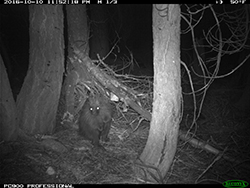
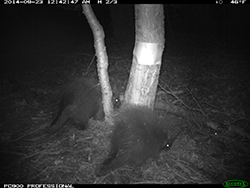
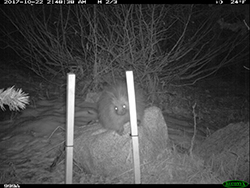
Not to put too fine a point on it, but studying California’s porcupines hasn’t traditionally been a high priority for CDFW.
Wildlife research funding is limited, especially for non-game species, and species listed as threatened or endangered are typically given top priority. That means that scientists sometimes need to be creative – and frugal – in their efforts to survey and manage non-listed, non-game species.
Stacy Anderson, a CDFW senior environmental scientist specialist based in Rancho Cordova, recently conducted a pilot project that does just that.
Anderson developed an interest in the North American porcupine (Erethizon dorsatum) in 2017, after acknowledging that anecdotal evidence seems to indicate their numbers are on the decline.
Porcupines have historically inhabited diverse habitats including Humboldt County, along the Sacramento River, in the Coast Ranges, the Klamath Mountains, the southern Cascades, the Modoc Plateau and the Sierra Nevada. But in her conversations with unit biologists and wildlife officers in some of these areas, Anderson took note that many were reporting a substantial decrease in the number of calls from residents whose property – typically wood structures such as decks and outhouses – had been damaged by porcupines in recent decades. Informal surveys of veterinarians across the state also indicated a decline in the number of pet owners seeking quill removal from their pets.
Perhaps most telling, CDFW’s Sierra Nevada monitoring project, which has studied portions of the Sierra for the past nine years, has documented only seven porcupine sightings out of 750 stations surveyed via trail camera.
“We are worried about them because we don’t have a lot of sightings,” Anderson said. They live in low densities and they have only have one baby per year, so they don’t repopulate quickly.”
Recognizing the need to gather more information, Anderson and Evan King, another CDFW environmental scientist, launched a pilot effort last year to improve surveillance of porcupine, with a long-term goal of determining distribution and population numbers.
Anderson and King were inspired by the work of Uldis Roze, a researcher who has long studied porcupines in the Catskills of New York by using wood soaked in salt brine as a porcupine attractant. His research indicates that porcupines show a strong seasonality of salt use, which peaks in April through May and August through September. Because porcupines’ diet of plant matter is generally low in sodium (salt), they seek out other dietary sources of sodium to maintain normal levels in their bodies.
Anderson and King theorized that brined wood could be effective in attracting California porcupines, too. A plan was made to soak stakes made from 2x2s in a sodium brine to monitor activity. In theory, tooth scrapings on the wood could also be identified to species.
“It’s not a full-blown study – it’s just a way to test a plan of action that can maybe be used in a study later,” Anderson explained. “We don’t want to waste valuable resources on untested methodology, so this is a way to find out first if the methodology is going to work. It’s a low-cost, high yield approach.”
Twenty-three stations were set up for the 2017 pilot project, which was conducted from April to October. Members of CDFW’s Natural Resources Volunteer Program, who support departmental operations, supplied much of the labor, and the study costs were kept low. Expenses added up to less than $100, including salt for brining and wood. Trail cameras borrowed from other researchers were utilized to help monitor the stations.
Researchers were pleased to learn that the porcupines took to their efforts with a grain of salt (so to speak). They determined that brined-wood monitoring is more effective than traditional bait or game-trail monitoring, at least in the study area in northern Sierra and along the Sacramento River. Preliminary results indicate that the brined wood appeared to lure porcupines into the area of a camera station -- although most did not approach the wood and fewer still left a distinctive chew mark on the brined wood. But the trail cameras provided clear, useful photographs.
“We still have unanswered questions about this technique that will need to be addressed before we can consider it a success,” Anderson said. “However, our pilot efforts are promising.”
CDFW is seeking additional funding through state wildlife grants and collaborative efforts with other researchers and agencies to gain a better understanding of the North American porcupine’s status. Anderson plans to continue refining the methodology of her study, along with other survey techniques including habitat surveys, feeding signs, tree girdling, scat searches and the use of detection dogs.
Anderson also encourages members of the public to help CDFW’s efforts by reporting detections of live or “roadkill” porcupines.
CDFW Photos. Top Photo: Porcupine photo by CDFW Warden Chad Alexander.